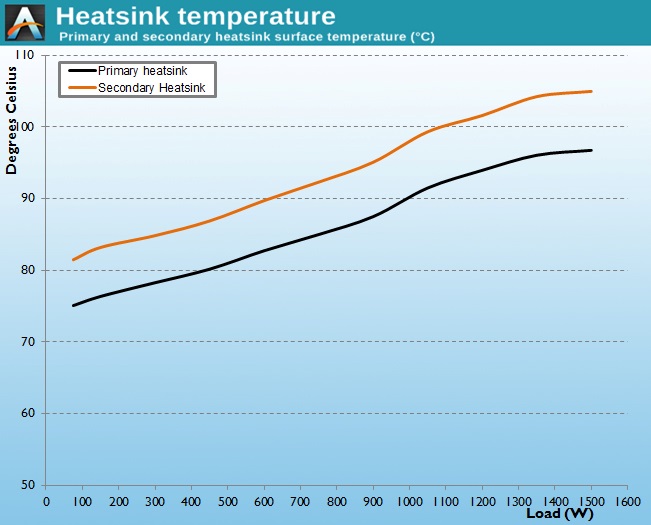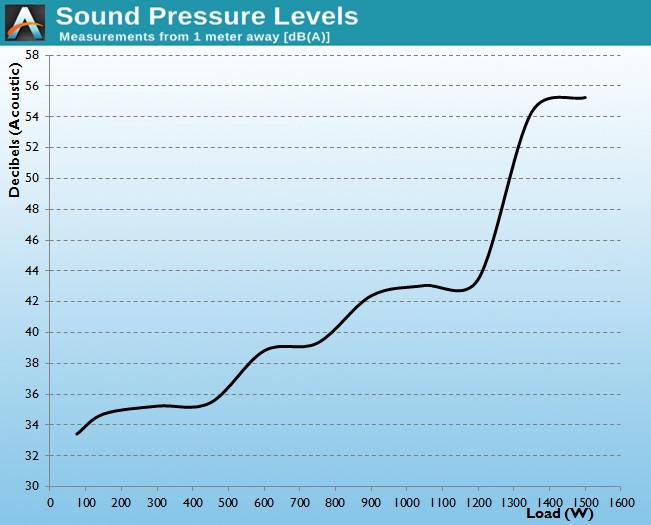The SilverStone Strider Gold S 1500W PSU Review
by E. Fylladitakis on April 7, 2015 8:00 AM EST- Posted in
- Cases/Cooling/PSUs
- PSUs
- SilverStone
- 1500W
Hot Test Results
As it can be seen in the following tables, SilverStone's currently most powerful PSU does offer outstanding power quality, especially if the massive power output is taken into account. The maximum voltage ripple on the 12V line is just 30mV at maximum load, under an outrageous current draw of nearly 110A. Ripple suppression is equally great on the minor voltage lines as well. Voltage regulation is a little more complicated, as the stability of the 12V line is amazing, with a change of less than 1% across the load range. However, the regulation of the 3.3V/5V lines is a lot less tight, at 2%/2.4% respectively.
| Main Output | ||||||||
| Load (Watts) | 303.02 W | 755.8 W | 1127.97 W | 1498.98 W | ||||
| Load (Percent) | 20.2% | 50.39% | 75.2% | 99.93% | ||||
| Line | Amperes | Volts | Amperes | Volts | Amperes | Volts | Amperes | Volts |
| 3.3 V | 4.55 | 3.39 | 11.38 | 3.38 | 17.07 | 3.34 | 22.76 | 3.33 |
| 5 V | 4.55 | 5.15 | 11.38 | 5.14 | 17.07 | 5.04 | 22.76 | 5.02 |
| 12 V | 21.85 | 12.09 | 54.63 | 12.06 | 81.94 | 12.02 | 109.26 | 11.98 |
| Voltage Ripple (mV) | |||||||
| Line | Regulation (20% to 100% load) |
||||||
| 20% Load |
50% Load |
75% Load |
100% Load |
CL1 12V |
CL2 3.3V + 5V |
||
| 3.3V | 2% | 6 | 8 | 14 | 20 | 10 | 26 |
| 5V | 2.4% | 6 | 10 | 16 | 24 | 10 | 30 |
| 12V | 0.9% | 8 | 16 | 22 | 30 | 34 | 16 |
Once again, we need to mention that this is a PSU rated at 40°C and we perform our testing at temperatures higher than 45°C - we could reduce the ambient temperature of our hotbox testing but we chose not to do so as the results would then not be comparable to those of our previous reviews.
According to these results, it becomes apparent that SilverStone is most likely just playing it safe regarding the 40°C rating for continuous operation. High ambient temperatures had little effect on the performance of the ST1500-GS, reducing its energy conversion efficiency by an average of just 0.3%. The maximum efficiency is reduced to 91.6% at exactly half load.
High temperatures are to be expected from a PSU with this kind of power output and the ST1500-GS does get terribly warm when fully loaded under these conditions. Do note however that the probe that is taking our secondary side readings is now sandwiched between the thermal pad and the chassis (that acts as the main secondary side heatsink), meaning that the readings are naturally higher than with other models. The cooling fan once again follows a "stepping" speed model - the only difference is that now the fan jumps up to maximum RPM at 90% load, correctly abandoning every notion of acoustic comfort to ensure reliability.















32 Comments
View All Comments
Sabresiberian - Wednesday, April 8, 2015 - link
"Albeit crude, the assembly quality certainly has room for improvement but it does not cause reliability concerns. "It might not cause concerns for you, but it sure does for ME.
I think we need a new set of standards to judge PSUs by. Long gone are the days when Tomshardware and others demonstrated that most PSUs designed for desktop computers were simply bad and it didn't take much digging to find out the truth of the matter. Now brand name companies and manufacturers up and down the line understand how to pass tests in reviews and build their PSUs to do so. Good news, we are less likely to buy one that fries our build in its lifetime.
Bad news, PSUs like this one slip in to the category of "acceptable" along with far better built devices. Name brands like Silverstone hide the fact that they farm their business out to the lowest bidder and some of their PSU lines are far from good or reliable. A bit of sloppy work here or there might not seem all that important until you think about how time and use magnify those weaknesses and can easily cause them to become real problems. And with a PSU, "real problems" can translate to a fried mainboard, CPU or other components that get taken out when it self-destructs.
Assembly quality is where engineering meets the real world, and a PSU is only as good as its weakest solder joint.
Oxford Guy - Thursday, April 9, 2015 - link
35 dB at 250 watts, 38 dB at 550 watts, 39 dB at 650 watts...